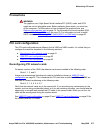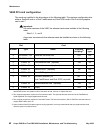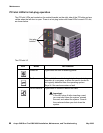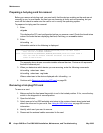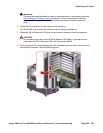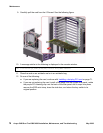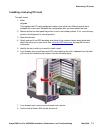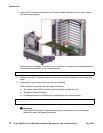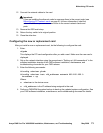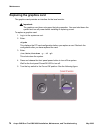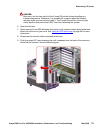
Maintenance
68 Avaya CMS Sun Fire V880/V890 Installation, Maintenance, and Troubleshooting May 2006
Preparing a hot-plug card for removal
Before you remove a hot-plug card, you must verify that the devices residing on the card are not
currently in use. In most cases, the card you are removing is faulty and not operating, but you
must still first check to make sure the card is not in use by the operating system.
To prepare a hot-plug card for removal:
1. Enter:
cfgadm
This displays the PCI card configuration before you remove a card. Check the Condition
column for cards that are displaying failed, failing, or unusable status.
2. Enter:
ifconfig -a
Information similar to the following is displayed:
The example above shows one administrable ethernet devices. Device eri0 represents
the built-in ethernet port.
3. When you determine which device you are removing, enter the following commands:
ifconfig <device> down
ifconfig <device> unplumb
Where <device> is the device displayed with ifconfig -a.
4. Continue with Removing a hot-plug PCI card
on page 68.
Removing a hot-plug PCI card
To remove a card:
1. Make sure that the front panel key switch is not in the locked position. If it is, move the key
switch to the diagnostic or normal position.
2. Open the left door.
3. Attach one end of an ESD antistatic wrist strap to the system chassis sheet metal and
attach the other end to your wrist. See Using an ESD wrist strap
on page 59 for more
information.
4. Identify which card you want to remove.
5. Disconnect the external cables connected to the card.
le0: flags=1000849<UP,LOOPBACK,RUNNING,MULTICAST,IPv4> mtu 8232 index 1
inet 127.0.0.1 netmask ff000000
eri0: flags=1000843<UP,BROADCAST,RUNNING,MULTICAST,IPv4> mtu 1500 index 2
inet 135.9.88.83 netmask ffffff00 broadcast 135.9.88.255
ether 0:3:ba:a:fe:85




